Le français suit / French follows
by: Dawn P. Richards (patient partner and Five02 Labs Inc, Toronto, Ontario, Canada) and Jim Elliott (independent advocate for patients in research, Wales, UK)
As more research teams include patient and public authors in their work, the topic of affiliation for these authors is coming to light. The academic publishing model is one which assumes that most, if not all, authors have an academic, health services or industry-based affiliation, however patient and public authors do not necessarily fit this mold. Given that research is bringing to light journal Editors-in Chief beliefs related to patient partner authorship (1), work that identifies how patient partners may meet International Committee of Medical and Journal Editors’ criteria for authorship in patient engagement and patient-oriented research projects (2), and most recently, a study on identifying scientific articles that include patient partner authors (3), we feel this is a timely discussion. Here we share our thoughts on this evolving situation, provide solutions for teams that include these types of authors, and issue a call to action for journal editors.
Patients and public authors, should they wish to be publicly cited as such in publications, should have an opportunity to choose their preferred type of affiliation. Currently it appears that many patient and public authors are affiliated with a patient organisation to which they belong or the organisation that carried out the research highlighted by the publication. While this may work for some patient and public authors, we argue that this is not the case for all patient and public authors, some of whom may wish to not have an institutional affiliation or who don’t have an institutional affiliation. In fact, for some patient and public authors, needing to affiliate with the institution that is leading the research may not be appropriate. While these individuals may have received some form of compensation for their contribution to the project highlighted in the publication, they are rarely under employment contract to these institutions and certainly rarely act or speak on behalf of the institution. To call these authors affiliated with these institutions may not be the correct interpretation of the relationship. Most patient partners bring an independent perspective to the research they get involved with and may feel that could be compromised by being affiliated to the institution. Being a co-author is a form of reward and recognition for the contribution patient and public authors have made to the research.
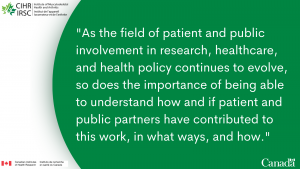
We propose that these patient and public authors should be able to choose their own affiliations and it is the responsibility of the lead author to offer that. We have recently seen some patient and public authors choose to list their affiliation as ‘patient partner’ or ‘patient research partner’ (4,5), or as the location where they live (6). We further suggest that terms such as ‘public partner’ (7) ‘independent patient or public partner,’ and others may be useful affiliations. In the event that patient and public authors do have affiliations that make sense for their situations, we also feel that appropriately highlighting that patient and public members have contributed to the work of the publication is important (3).
We are bringing this issue to light because we feel strongly about contributing to the science and knowledge related to patient and public engagement and involvement. This is an emerging field, and it is important to realize that current processes and systems do not easily accommodate patient and public involvement. As the field of patient and public involvement in research, healthcare, and health policy continues to evolve, so does the importance of being able to understand how and if patient and public partners have contributed to this work, in what ways, and how. Current tools such as the GRIPP (8) and GRIPP2 (9) reporting tools are helpful, as are simple approaches such as detailing who patient and public partners are within the contributions section of publications. Whilst that is clearly important, the contributions section is usually placed at the end of most papers and may be missed by some readers. We feel that it is important that the contribution of patient and public authors is made more visible through an appropriate affiliation on the first page. Moving towards this as a choice for all patient and public contributors to research will start to reveal the full extent and impact of the contributions they make, which has hitherto been far from clear in journal papers (10). The lack of a clear way to indicate that one or more co-authors is a patient and public author leads to an underreporting of the numbers of patient and public partners who have contributed to the writing of published papers. It might also give the impression that patient and public authors lack the skills to do this or that they are not interested, neither of which is true in our experience.
With this context, we issue a call to action to journal editors to develop an approach to help ensure that patient and public authors who want to be recognised as such can use an affiliation of their choice. At its most basic form, journal submission software should offer flexibility to allow for this type of ‘affiliation.’ A more advanced exercise would be to develop guidance for lead authors in collaboration with patient and public contributors who have been co-authors of published papers. Specific approaches might need to be developed for academic, commercial and health services organisations that offer some options for appropriate affiliations.

L’affiliation des patients et du public dans les articles scientifiques : une ambiguïté gênante
Par Dawn P. Richards, patiente partenaire et fondatrice de Five02 Labs à Toronto en Ontario (Canada) et Jim Elliott, défenseur des droits des patients dans la recherche au pays de Galles (Royaume-Uni)
La contribution de patientes, de patients et de membres du public à la rédaction d’articles scientifiques se généralise et projette sur le devant de la scène la question épineuse de leur affiliation. Il est en effet tenu pour acquis que les personnes qui soumettent des articles scientifiques exercent professionnellement dans le milieu de la recherche universitaire, dans les services de santé ou dans l’industrie et possèdent à ce titre une affiliation à un établissement, ce qui ne s’applique pas aux patientes, aux patients et aux membres du public. Au regard des idées reçues d’un certain nombre de rédactrices et rédacteurs en chef à l’égard des articles qui portent la signature de patientes et patients partenaires (1), des conditions de publication que l’International Committee of Medical Journal Editors impose à ces personnes en cas de participation à des projets de mobilisation ou de recherche axée sur le patient (2) et plus récemment d’une étude centrée sur les articles scientifiques en copublication par des patientes et patients partenaires (3), nous estimons que le temps est venu de traiter le sujet. Dans les paragraphes qui suivent, nous exprimons notre position sur une situation en constante évolution, offrons des recommandations aux équipes souhaitant s’appuyer sur des auteures et auteurs présentant un tel profil et lançons un appel à l’action à l’intention des rédactions des revues scientifiques.
Les personnes qui souhaitent publier des articles en qualité de patientes, patients ou membres du public devraient être libres de choisir l’affiliation qui correspond à leur situation. À l’heure actuelle, nombre d’entre elles sont affiliées à l’organisation de patients qui les représente ou à l’établissement qui pilote le projet de recherche auquel elles participent. Si cette affiliation reflète dans certains cas la véritable nature des rapports établis, nous considérons que cela ne concerne pas l’ensemble des patientes, patients ou membres du public qui écrivent des articles et que ces personnes sont en droit de ne pas être affiliées à un établissement. Cette procédure n’est d’ailleurs pas toujours la voie à suivre. Si les établissements responsables des projets mis en exergue dans un article scientifique rémunèrent parfois les patientes, patients ou membres du public qui y ont participé, cela ne signifie en effet pas pour autant qu’ils le font dans le cadre d’un contrat de travail ou qu’ils accordent à ces personnes une autorisation d’agir ou de s’exprimer en leur nom. En de telles circonstances, considérer qu’il existe une relation d’affiliation serait pour le moins inexact. De plus, la plupart des patientes et patients partenaires apportent des points de vue uniques aux équipes qui sollicitent leur aide et perçoivent la copublication d’un article comme une forme de récompense et de reconnaissance des efforts qu’elles déploient au service de la recherche. Une affiliation à l’établissement responsable du projet pourrait en ce sens entraver leur sentiment d’indépendance intellectuelle.

À la lumière de ces observations, nous recommandons que les patientes, patients et membres du public participant à la rédaction d’articles scientifiques aient la liberté de choisir leur affiliation en toute indépendance et qu’il revienne à l’auteure principale ou à l’auteur principal de ces articles de la leur offrir. Nous avons récemment remarqué que les noms de « patient partenaire », de « patient partenaire à la recherche » (4, 5) et même du lieu de résidence (6) figurent parmi les affiliations choisies. Les termes « partenaire du public » (7) et « patient indépendant ou partenaire du public » méritent également considération. Dans les cas où l’affiliation de patientes, patients ou membres du public à un établissement est parfaitement légitime, nous estimons que la reconnaissance en bonne et due forme de leur contribution à la rédaction de l’article publié est tout aussi importante (3).
Nous nous exprimons sur ce sujet en raison de l’importance que nous accordons à la science de la mobilisation et de l’implication du public, des patientes et des patients dans la recherche. Cette approche vit ses premières heures, mais il est d’ores et déjà essentiel de prendre conscience que les processus et systèmes de publication actuels sont particulièrement rigides à l’encontre des personnes qui ne possèdent pas d’affiliation. À mesure que la mobilisation du public, des patientes et des patients dans la recherche, les pratiques de soins et les politiques de santé prendra de l’ampleur, il deviendra essentiel de disposer de moyens permettant d’évaluer précisément leur contribution aux travaux menés. Les outils actuels, qui suivent le modèle GRIPP (8) et GRIPP2 (9), prouvent leur utilité, tout comme les approches simples consistant à offrir, dans la section Contributions des articles, des informations sur l’identité et l’apport des patientes, patients et membres du public à leur rédaction. Malgré son importance, nous notons néanmoins que cette section est généralement placée à la fin des articles et tend à ne pas attirer l’œil du lectorat, raison pour laquelle nous recommandons qu’elle bénéficie d’une meilleure exposition sur la première page. Une telle décision en faveur du public, des patientes et des patients qui participent à la recherche permettrait de souligner sans équivoque leurs contributions, ce qui, en l’état actuel des choses, serait une petite révolution (10), d’autant plus que l’absence de consensus autour de la question de la mise en évidence du statut de patiente, de patient ou de membre du public dans la copublication d’articles se traduit par une sous-estimation de leur nombre réel et donne en outre l’impression que ces personnes ne possèdent pas les compétences requises pour écrire des articles ou que l’exercice ne les intéresse tout simplement pas, ce qui dénote un décalage net avec la réalité que nous observons.
Dans ce contexte, nous appelons l’ensemble des rédactions des revues scientifiques à mettre au point une approche qui accordera aux personnes qui contribuent à la publication d’articles à titre de patientes, de patients et de membres du public la liberté de choisir leur affiliation. Au minimum, les logiciels de soumission d’articles scientifiques devraient offrir à ces personnes la possibilité de sélectionner le type d’affiliation qui correspond à leur situation. Bien que l’exercice soit plus complexe, l’idéal serait toutefois d’établir des lignes directrices à l’intention des auteures principales et auteurs principaux qui publient leurs articles en collaboration avec des patientes, des patients ou des membres du public. Des approches adaptées aux besoins des établissements universitaires, des organismes du secteur commercial et des services de santé qui proposent des possibilités d’affiliation justes pourraient également être étudiées.

References / Références
- Cobey, K.D., Monfaredi, Z., Poole, E. et al. Editors-in-chief perceptions of patients as (co) authors on publications and the acceptability of ICMJE authorship criteria: a cross-sectional survey. Res Involv Engagem 7, 39 (2021). https://doi.org/10.1186/s40900-021-00290-1
- Richards, D.P., Birnie, K.A., Eubanks, K. et al. Guidance on authorship with and acknowledgement of patient partners in patient-oriented research. Res Involv Engagem 6, 38 (2020). https://doi.org/10.1186/s40900-020-00213-6
- Oliver, J., Lobban, D., Dormer, L. et al. Hidden in plain sight? Identifying patient-authored publications. Res Involv Engagem 8, 12 (2022). https://doi.org/10.1186/s40900-022-00346-w
- Richards, D.P., Jordan, I., Strain, K., Press, Z. Patients as Partners in Research: How to Talk About Compensation With Patient Partners, Journal of Orthopaedic & Sports Physical Therapy, 50, 8 (2020). https://www.jospt.org/doi/10.2519/jospt.2020.0106
- Richards, D.P., Cobey, K.D., Proulx, L. et al. Identifying potential barriers and solutions to patient partner compensation (payment) in research. Res Involv Engagem 8, 7 (2022). https://doi.org/10.1186/s40900-022-00341-1
- Tembo D, Hickey G, Montenegro C, Chandler D, Nelson E, Porter K et al. Effective engagement and involvement with community stakeholders in the co-production of global health research BMJ 2021; 372 :n178 doi:10.1136/bmj.n178
- Newlands, R., Duncan, E., Presseau, J. et al. Why trials lose participants: A multitrial investigation of participants’ perspectives using the theoretical domains framework. J. Clin. Epidemiol. March 12, 2021, https://doi.org/10.1016/j.jclinepi.2021.03.007
- Staniszewska, S., Brett, J., Mockford, C., & Barber, R. (2011). The GRIPP checklist: Strengthening the quality of patient and public involvement reporting in research. International Journal of Technology Assessment in Health Care, 27(4), 391-399. doi:10.1017/S0266462311000481
- Staniszewska S, Brett J, Simera I, Seers K, Mockford C, Goodlad S et al. GRIPP2 reporting checklists: tools to improve reporting of patient and public involvement in research BMJ 2017; 358 :j3453 doi:10.1136/bmj.j3453
- Public Involvement in Research Impact Toolkit (PIRIT). See section on ‘The difference public contributors make to the research outcomes and dissemination of results’https://www.cardiff.ac.uk/marie-curie-research-centre/patient-and-public-involvement/public-involvement-in-research-impact-toolkit-pirit

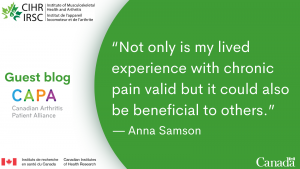
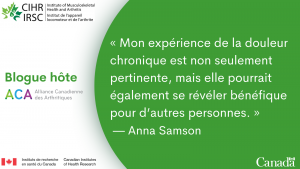


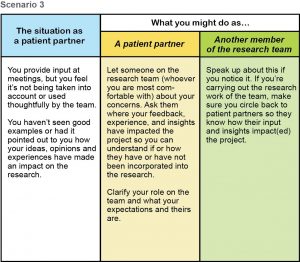


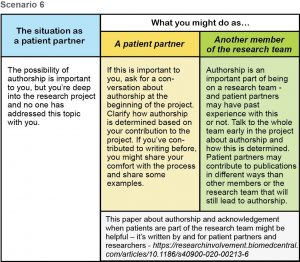 Download .pdf:
Download .pdf: